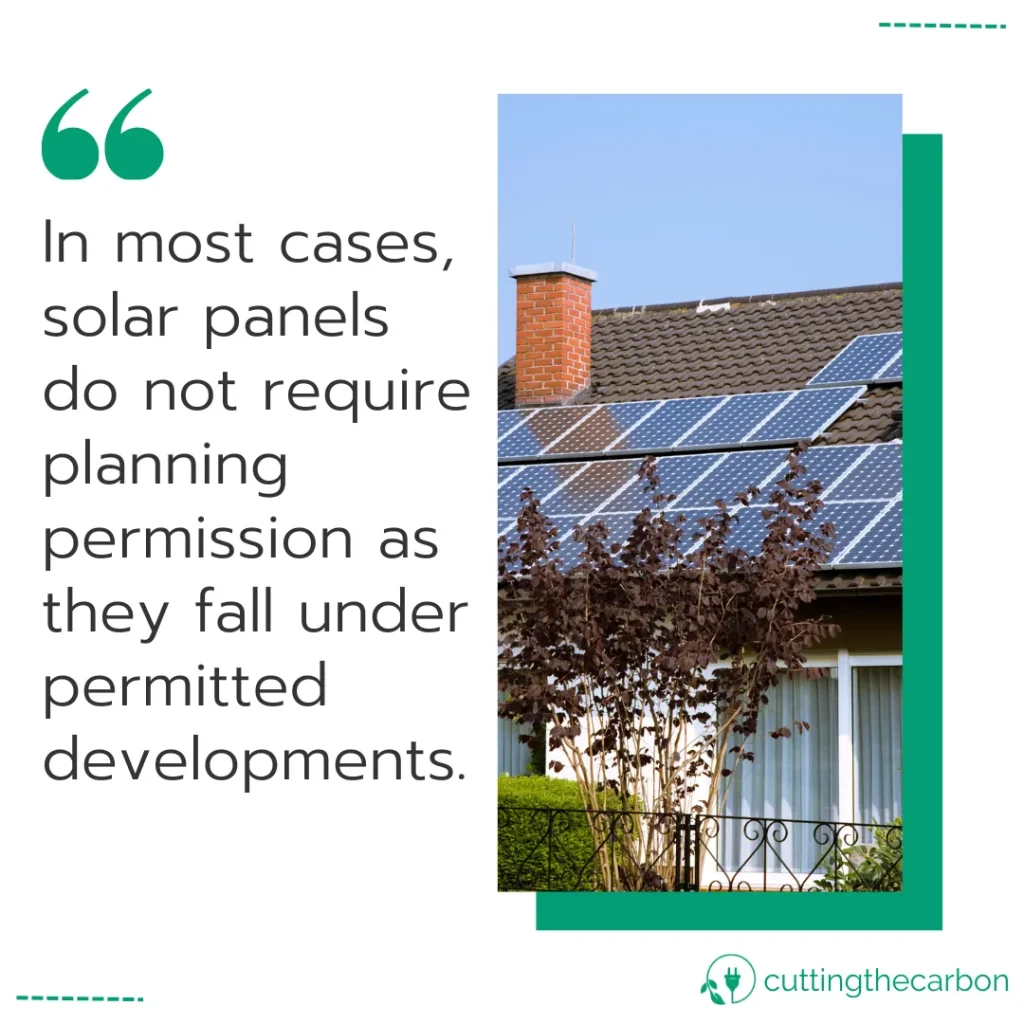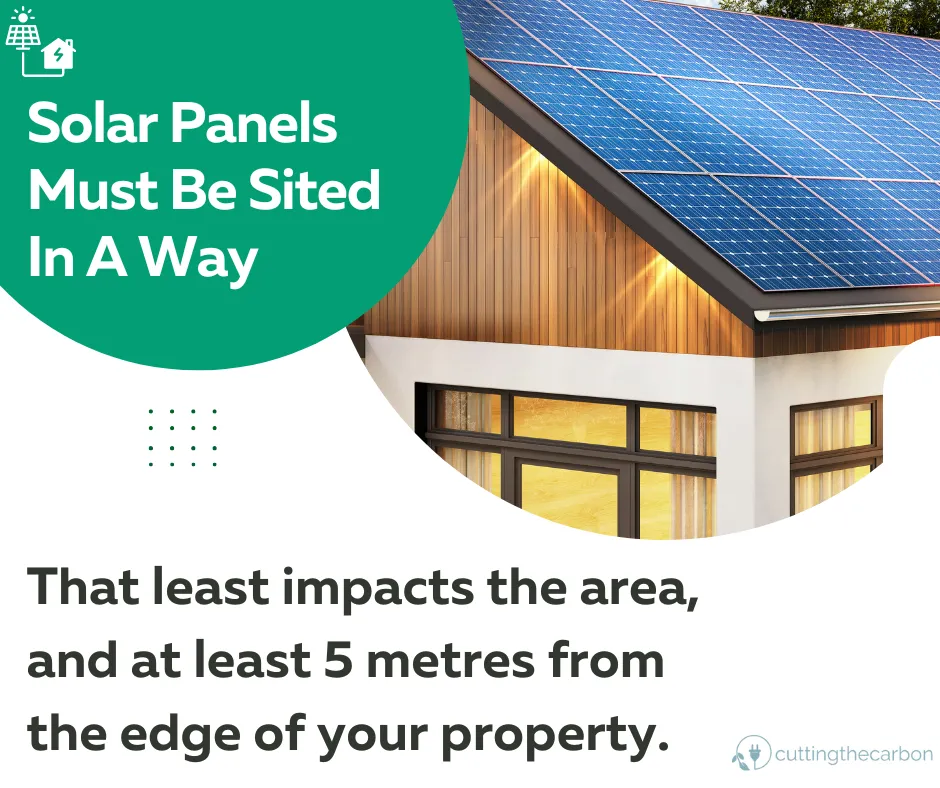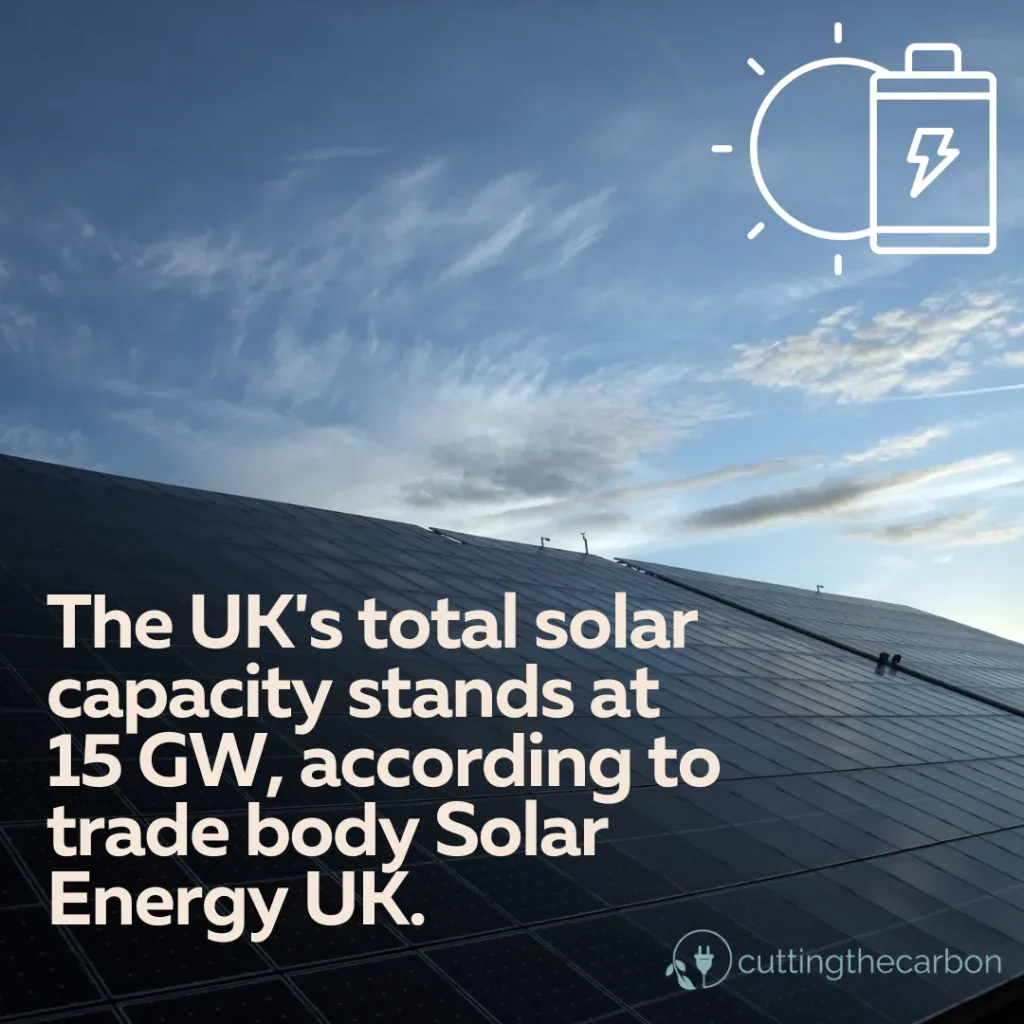Do you need planning permission for solar panels? It’s a question that stumps many homeowners.
Excitement at the prospect of renewable energy can be offset by confusion over its legal requirements, especially when it comes to understanding the legalities and permissions involved.
You might have heard about ‘permitted development rights’ or perhaps stories from friends who’ve installed their own systems without any fuss. But does this apply to everyone? And more importantly, does it apply to you?
This guide will help clear up some confusion around whether you need planning permission for solar panels in the UK. We’ll delve into what exactly ‘permitted development’ means and highlight certain situations where additional permissions may be required.
In Summary:
- In the UK, most solar panels do not require planning permission.
- Planning permission may be needed in conservation areas or on listed buildings.
- The installation must adhere to specific size and positioning rules.
- It’s advisable to consult with the local planning authority to confirm.
Table of Contents

The Basics of Solar Panels and Planning Permission
So, you’re considering making the switch to solar power. You’ve heard about how it can save money on your energy bills while reducing carbon emissions – a win-win situation for both your pocket and the environment.
But before diving into this exciting venture, one crucial aspect needs consideration: planning permission.
In essence, planning permissions are approvals from local authorities confirming that building works meet certain standards and regulations. This includes installations like solar panels, which in most cases fall under ‘permitted development rights’, meaning no explicit consent is needed.
Delving Deeper Into Permitted Development Rights For Solar Installations
‘Permitted development rights’, as they relate to installing solar panel systems, essentially mean homeowners have the freedom to carry out minor improvements without needing formal approval from their local authority. This does not imply an automatic green light, though.
Certain limits must be adhered to strictly. The government has outlined specific conditions related directly to these permitted developments (When Is Permission Required?).
If these conditions are not fully met, then full-blown planning permission may still be required – especially if the installation takes place within conservation areas or listed buildings.
Navigating Through Exceptions In Planning Permissions For Installing Solar Panels
To avoid any unwelcome surprises down the line, it’s important for potential owners looking to invest in renewable solutions such as PV systems to familiarise themselves with all relevant rules before venturing further ahead.
Permitted Development Rights and Solar Panels
The term ‘permitted development’ is a key factor in the process of installing solar panels. This refers to specific types of work that can be executed on your property without needing planning permission.
In recent years, the government extended permitted development rights, making it more straightforward for homeowners to embrace green technology solutions like solar panels.
Under normal circumstances, these installations fall under permitted development rights; hence you typically won’t need explicit planning permission from your local authority before proceeding with the installation.
Understanding the Limits and Conditions
To leverage these benefits associated with permitted development when setting up a solar panel system, there are certain conditions which must be met.
The first condition pertains to aesthetics: any equipment installed should have minimal impact on how your home looks externally so as not to compromise its character or appeal.
A second critical aspect involves the removal of equipment if no longer needed due to changes in energy usage patterns or the adoption of alternative renewable energy options.
It’s essential that our residential buildings maintain their aesthetic integrity while promoting sustainable living practices at all times.
If one fails to meet these criteria, then, unfortunately, this would mean seeking out planning permission may become necessary even though generally speaking most instances fall into designated ‘permitted development’.
Hence understanding what constitutes permissible within regulations becomes paramount.

When is Planning Permission Required?
As mentioned above solar panels, as a rule of thumb, fall under ‘permitted development’ rights. However, planning permission may be required in certain cases; for instance when installing solar panels on a flat roof due to potential visual impact.
The first instance when this might be the case involves flat roofs. Unlike their sloping counterparts which can accommodate flush-fitting installations without affecting external aesthetics too much, standalone systems on flat roofs could require planning permission due to potential visual impact.
Consulting Your Local Planning Authority
It’s essential to talk with your local planning department prior to beginning setup plans if you find yourself in this situation. They will guide you through whether or not an application for planning permission needs to be made based on project specifics and local regulations.
Your council website should have information about how to get in touch with their town planners directly, but if not, The Planning Portal provides a handy tool allowing easy access across England and Wales.
If your property happens to sit within a conservation area or World Heritage Site, additional restrictions apply when looking at installing solar panels.
In such areas, changes impacting character or appearance often necessitate formal consent from relevant authorities due to their sensitive nature – so don’t forget those heritage preservation considerations.
Complying with Normal Building Regulations
Solar panels and planning permission often go hand in hand but let’s not forget the normal building regulations. These are a set of standards that need to be met when installing solar panel systems on residential buildings.
The concept is simple: even if your project falls under permitted development rights or you’ve received planning permission, there’s still an obligation to comply with these regulations. They’re designed for safety purposes and quality assurance during installation.
Unpacking The Essentials Of Building Regulations
A qualified electrician must be employed to carry out all electrical work connected with the installation of solar panels, guaranteeing safe operation and avoiding any potential risks caused by faulty installation. This ensures safe operation post-installation and eliminates any potential hazards associated with poorly installed electrics.
- Safety First: All installations should meet fire safety requirements as well as provide secure access for maintenance tasks.
- Rooftop Load-Bearing Capacity: Your roof structure needs adequate strength support so it can withstand the weight of the solar PV system without causing structural damage over time.
- Eco-Friendly Disposal Methods: You’ll also have equipment like inverters and batteries associated with your new green technology solution – provisions should exist for environmentally friendly disposal or recycling at their end-of-life stage.

Installing Different Types of Solar Systems
Solar systems come in two primary types: solar photovoltaic (PV) and solar thermal. Each has its own unique characteristics, benefits, and considerations regarding planning permission.
Solar Photovoltaic (PV) System
The first type is the solar PV system. Semiconductors with the photovoltaic effect are utilised to directly transform sunlight into electricity by this technology. It’s a great way to generate your own power for immediate use or storage for later consumption.
In terms of planning permission, you’ll be pleased to know that installing a roof-mounted solar PV system usually falls under permitted development rights in most residential buildings.
That means there is no need for explicit consent from your local planning authority if certain conditions are met, such as not protruding more than 200mm beyond the plane of any existing wall or roof slope.
Solar Thermal System
The second option at hand is a solar thermal system. Unlike their PV counterparts which produce electricity, these systems harness heat energy from sunlight to warm up water used domestically within homes.
They typically include collectors mounted on roofs which absorb this heat energy and transfer it via a fluid medium towards hot water tanks ready for use.
If we’re talking about ‘permitted development’, well-installed domestic scale units generally qualify too.
However, remember that there might still be some hoops you have to jump through if living within listed building premises or conservation areas where additional consent could become necessary before proceeding with installation works.
So always consult with your local planning authority prior to committing time and resources.
The Impact on Listed Buildings
As the drive for green energy solutions gains momentum, solar panels have become a popular choice among homeowners. However, if your home is classified as a listed building – one of architectural or historical significance – there are additional considerations to take into account.
Listed buildings have their own set of rules and regulations to be followed when making changes, such as fitting solar panels, which could alter the exterior appearance. This includes installing solar panel systems that could alter the external appearance of these structures.
Understanding Listed Building Consent
To install solar panels on such properties requires ‘listed building consent’. This process ensures any changes made do not negatively impact the character or aesthetic value of your property.
Even though you might be looking at permitted development rights for most installations, this doesn’t automatically apply to listed buildings.
In many cases, adding photovoltaic cells (PV) will significantly change how your house looks from the outside, warranting permission before proceeding with the installation.
Remember, every application is assessed individually, so don’t assume that what may work elsewhere would also hold true for you without seeking advice first.
Navigating Planning Permission with Listed Buildings
Your local planning authority can provide guidance about getting planning permission specific to heritage sites like yours, considering its unique nature and legal protections afforded by law while ensuring all necessary conditions are met before commencing installation works.
They play an important role in preserving our shared history even as we move towards more sustainable living practices through renewable energy projects like PV system installations.
The Importance Of Specialist Advice
Making modifications, such as adding PV modules onto historically significant residential buildings, often calls for specialist knowledge given their special status under normal building regulations.
Hence, it’s advisable that owners consult professionals experienced in dealing with renewable energy initiatives within conservation areas before embarking upon an undertaking themselves.
It’s essential to strike a balance between adopting modern technology whilst maintaining respect for cultural heritage, which makes each structure a uniquely valuable part of the community landscape.
Installing solar panels on listed buildings in the UK requires ‘listed building consent’ due to their historical or architectural significance. This process ensures any alterations don’t compromise the property’s character. Always consult professionals with experience in renewable energy projects within conservation areas before proceeding.
What Happens After Receiving Planning Permission?
The moment you’ve received planning permission or determined that your solar panel project is within the realm of permitted development rights, it’s time to shift gears. Now we’re moving from paperwork and permissions into tangible action – getting those shiny new panels up on your roof.
1. Engage a Solar Panel Installer
Your first port of call? Find an expert installing solar panels who can guide you through this next phase professionally and precisely.
This isn’t just about finding someone who knows their way around a toolbox; they need to be able to assess your property thoroughly, considering factors like roof orientation, potential shading issues, and even the structural integrity of the building itself when designing an optimal layout for installation.
To ensure quality workmanship, opt for installers registered under the Microgeneration Certification Scheme (MCS).
This ensures adherence to industry standards throughout all installation stages, ultimately impacting efficiency and the longevity associated with the installed system.
2. Schedule Your Installation
You’ve got approval from local authorities – check. You have found a reliable installer – another big tick off the list. The next step is scheduling the actual date for the commencement of works related to setting up an energy-efficient powerhouse atop your home structure.
- Determine a suitable timeframe with the professional contractor, considering the size and scope involved and the weather conditions likely during the proposed period to set out planned activities.
- If any adjustments were required by the local authority, such as relocating the position or reducing the number of modules, then make sure these changes are communicated before starting operations so no hiccups occur down the line, leading to unnecessary delays or complications.
3. Maintain Post-Installation
A prosperous ending doesn’t signify the end of the process but rather the start of a long-term association between the proprietor and their newly fitted photovoltaic setup. Maintenance is crucial in ensuring optimum performance levels over a lifespan that typically lasts 25 years or more.
Once you’ve got planning permission for solar panels, it’s time to find a certified installer and schedule your installation considering all factors like roof orientation and weather conditions. Remember, post-installation maintenance is key to keeping the energy-efficient powerhouse running smoothly.
FAQs Relating To Do You Need Planning Permission for Solar Panels
Is planning permission required for solar panels in the UK?
Solar panels are usually considered ‘permitted development’ in the UK and do not require planning permission. However, certain conditions and limits must be met.
How many solar panels can you have without planning permission?
The number of solar panels isn’t typically restricted, but their installation should not protrude more than 200mm beyond the plane of a roof or higher than the highest part of it.
Do I need my neighbours’ permission for solar panels?
No, you generally don’t need your neighbours’ consent to install solar panels unless they infringe on their property rights or breach shared agreements.
Conclusion
We’ve explored the basics, understanding their benefits and why solar panel installations are becoming increasingly popular in UK homes.
We looked into permitted development rights, learning that usually, you don’t need planning permission for solar panels – but there are exceptions to every rule.
The ins and outs of local planning authorities have been navigated, and we now know when to consult them before installation begins. Even without requiring planning permission, it’s clear that normal building regulations still play a pivotal role in this process.
A thorough look at costs revealed some interesting insights about whether or not these green powerhouses are worth the investment. Different types of systems were put under our microscope, highlighting how their installation processes might differ.
Finally, we discovered what happens after receiving planning permission or establishing your project as ‘permitted development’ – it’s time to get those panels up.

